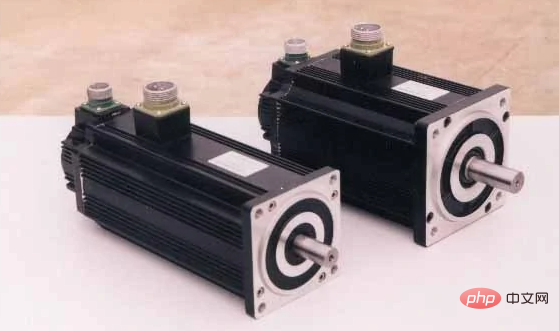What is a servo motor
Servo motor refers to the engine that controls the operation of mechanical components in the servo system. It is an indirect transmission device that assists the motor. The servo motor can control the speed and the position accuracy is very accurate. It can convert the voltage signal into torque and The rotation speed is used to drive the control object and convert the received electrical signal into the angular displacement or angular velocity output on the motor shaft.

The operating environment of this tutorial: Windows 10 system, DELL G3 computer.
What is a servo motor
The servo motor (servo motor) refers to the engine that controls the operation of mechanical components in the servo system. It is an indirect transmission device that assists the motor.
The servo motor can control the speed, the position accuracy is very accurate, and the voltage signal can be converted into torque and rotational speed to drive the control object. The rotor speed of the servo motor is controlled by the input signal and can respond quickly. In the automatic control system, it is used as an actuator and has the characteristics of small electromechanical time constant and high linearity. It can convert the received electrical signal into the motor shaft. Angular displacement or angular velocity output. They are divided into two categories: DC and AC servo motors. Their main feature is that there is no rotation when the signal voltage is zero, and the rotational speed decreases at a constant speed as the torque increases.

Introduction to working principle:
The servo mechanism controls the position, orientation, status and other outputs of the object. An automatic control system that can follow any changes in the input target (or given value). The servo mainly relies on pulses for positioning. Basically, it can be understood this way. When the servo motor receives a pulse, it will rotate at an angle corresponding to the pulse to achieve displacement. Because the servo motor itself has the function of sending out pulses, the servo motor will rotate every time it receives a pulse. When you rotate an angle, a corresponding number of pulses will be emitted. In this way, it will echo the pulses received by the servo motor, or it is called a closed loop. In this way, the system will know how many pulses are sent to the servo motor, and how many pulses are received back at the same time. , In this way, the rotation of the motor can be controlled very accurately, thereby achieving precise positioning, which can reach 0.001mm. DC servo motors are divided into brushed and brushless motors. Brush motors have low cost, simple structure, large starting torque, wide speed range, easy control, and require maintenance, but they are inconvenient to maintain (changing carbon brushes), generate electromagnetic interference, and have environmental requirements. Therefore it can be used in cost-sensitive general industrial and civil applications.
Brushless motors are small in size, light in weight, large in output, fast in response, high in speed, small in inertia, smooth in rotation and stable in torque. The control is complex and easy to realize intelligence. Its electronic commutation method is flexible and can be square wave commutation or sine wave commutation. The motor is maintenance-free, has high efficiency, low operating temperature, very small electromagnetic radiation, long life, and can be used in various environments.
AC servo motors are also brushless motors and are divided into synchronous and asynchronous motors. Synchronous motors are generally used in motion control. They have a large power range and can achieve high power. Large inertia, maximum rotation speed is low, and decreases rapidly as power increases. Therefore, it is suitable for applications with low speed and smooth operation.
The rotor inside the servo motor is a permanent magnet. The U/V/W three-phase electricity controlled by the driver forms an electromagnetic field. The rotor rotates under the action of this magnetic field. At the same time, the encoder of the motor feeds back signals to the driver. The driver compares the feedback value with the target value and adjusts the rotor rotation angle. The accuracy of the servo motor depends on the accuracy (number of lines) of the encoder.
The functional difference between AC servo motor and brushless DC servo motor: AC servo is better because it is controlled by sine wave and the torque ripple is small. DC servo is a trapezoidal wave. But DC servo is relatively simple and cheap.
For more related knowledge, please visit the FAQ column!
The above is the detailed content of What is a servo motor. For more information, please follow other related articles on the PHP Chinese website!

Hot AI Tools

Undresser.AI Undress
AI-powered app for creating realistic nude photos

AI Clothes Remover
Online AI tool for removing clothes from photos.

Undress AI Tool
Undress images for free

Clothoff.io
AI clothes remover

Video Face Swap
Swap faces in any video effortlessly with our completely free AI face swap tool!

Hot Article

Hot Tools

Notepad++7.3.1
Easy-to-use and free code editor

SublimeText3 Chinese version
Chinese version, very easy to use

Zend Studio 13.0.1
Powerful PHP integrated development environment

Dreamweaver CS6
Visual web development tools

SublimeText3 Mac version
God-level code editing software (SublimeText3)

Hot Topics
 1657
1657
 14
14
 1415
1415
 52
52
 1309
1309
 25
25
 1257
1257
 29
29
 1229
1229
 24
24


